

A global archive of independent reviews of everything happening from the beginning of the millennium
Read our Copyright Notice click here
For publication dates click here
21 March 2025
I am pleased to say the second electro // acoustic day is underway with the St Catherine's College Choir having performed the Carmack composition award entries. The day now has multiple participants from all over Europe and looks well on its way to being an annual event.
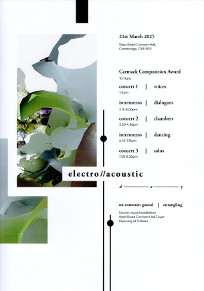
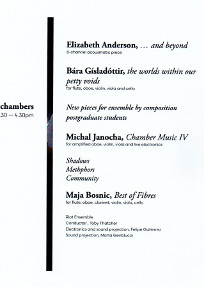
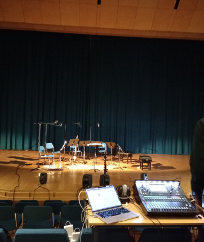
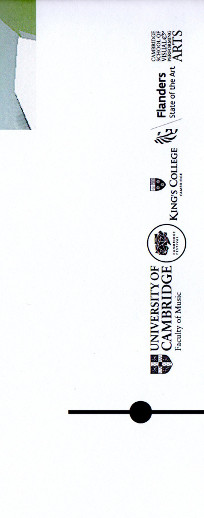
ELECTRO // ACOUSTIC DAY
Reviewed by ANDRE BEAUMONT
The faculty of music at the University of Cambridge now teaches electro.
I attended the first electro // acoustic day which I hope becomes an annual event.
I am very familiar with sound from multiple point sources from listening to organ music (each pipe is a point source) and to sound coming off note as it reflected, sometimes multiple times as in a Gothic church, to meld into a glorious whole where you are hearing hundreds of tones at once .... and with the limitations of electronics to reproduce this.
Nevertheless, with electro you can get to hear multiple tones, and sounds off note, blending into the whole so it can appeal to those who like a sophisticated soundscape.
The comparison may be inexact (and I am excluding impressionist composers like Debussy) but there is something in common with pointilliste painting in visual perception.
The concerts did not run into one another continuously so in the event I only attended one but should there be another year I will probably dig in for a full day as I should like to learn more about acoustic elements.
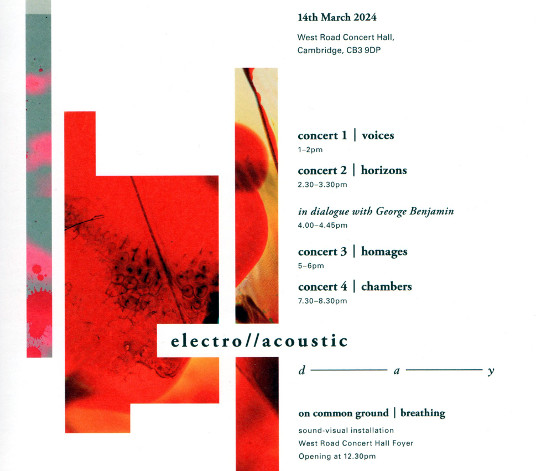
I went to the concert given by the invitees from the University of Greenwich which from the synopsis promised to be the most electro. Unlike the other concerts there would be no performers or instruments before us.
Controversially perhaps, as others are entitled to come to a different conclusion, I am no fan of the acoustic at the West Road Concert Hall or the way its sound system is sometimes employed in support so I was eager to see what the venue would sound like in the electro // acoustic context. In this case an extended range of speakers were used without live performance.
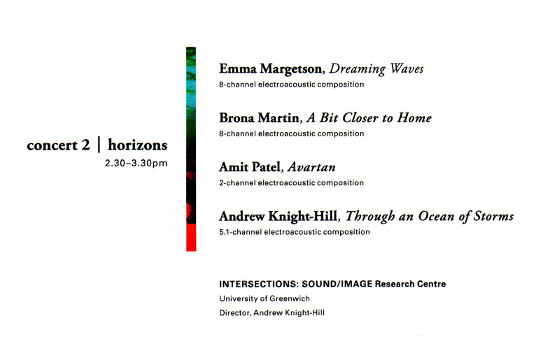
I really enjoyed this concert.
The 8-channel pieces were using surround sound, the 5.1 piece cinema-style surround sound and the 2-channel piece whatever the underpowered resident speakers could crank out, possibly supplemented. The performances were in the dark, like at a cinema, but without the peaks of volume and, if there was a subwoofer somewhere I did not register it. Not that this mattered as the larger space made listening to recordings more enjoyable than listening to ambient or electronic music at home. Like with organ music you are still subconsciously registering how long sound is taking to reach you which you may not have to do at home as you have long since registered the distance of your speakers and the principal reflections.
The concert used a different running order to the programme.
Dreaming Waves settled us in well to enjoying something spacious. The sound rippled like waves through the space, rich in texture. It used recordings, archival material and electronically generated sound. Part of the point of such a piece is surely that it simulates distance and the power of waves.
The synopsis for Arvatan was as good as an invitation to come to this concert for me as the piece 'explores how noise and sound-induced music should be felt as vibration, rather than heard with the cochlear' something I am interested in with respect to organ music and experienced in designing underground stations. You do, after all, want to know the train is coming with plenty of notice.
You did hear some of the music through the seats and the floors but the venue's own speakers are a little anaemic in the bass and it would be really interesting if this team could be invited back to play such a piece through multiple speakers in one of our Gothic chapels.
The fabric would really vibrate in some.
I have long been curious how to design a space and then place speakers, including subwoofers, in it that would reproduce the sound of organ music in a realistic way but from recordings.
Since this piece can, in part, be heard by other means than conventional, at least as composed, it does extend accessibility (just as you want to hear the train coming even if you are deaf or blind, or the organ composition, at least to some extent, if you are the former.)
A Bit Closer to Home includes sounds near to a bridge and on the Shannon and recollection of rowing on the river with a male Irish voiceover describing soundscapes with deep personal significance embedded in memory and evocative of time past. This is very compelling.
Reflections of sound off water can be very unique as to time and place as can, in many instances, the sound of moving water.
Mechanical and engineering sounds find their way into the piece including of a sawmill that is no longer there. Changing soundscapes give information about the history of a place.
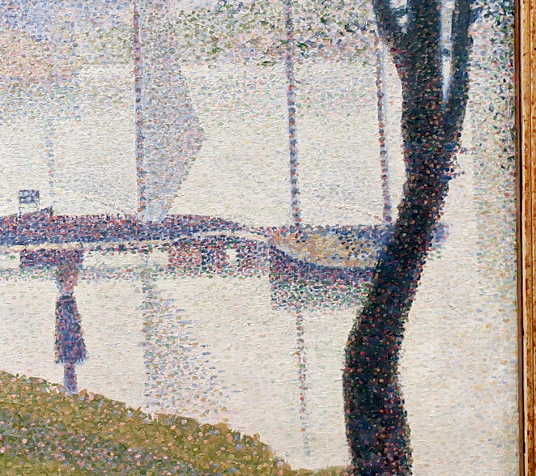
Georges Seurat, detail from The Bridge at Courbevoie, 1886-87, Courtauld galleries, Somerset House
Through an Ocean of Storms was composed as the soundtrack of a short film to celebrate the 50th anniversary of Apollo 12 and in sound terms might be the best suited to the acoustic of West Road as if you sit close to the stage it can feel liike a cinema but lacking most of the absorbant materials. It uses audio and radio communications from Apollo 12 combined with an extended trumpet solo that is an auditory shortcut to evoking some of the exploratory and heroic components of the space missions. It does also point a way as to how electro // acoustic compositions can be monetised or at least given wider circulation.